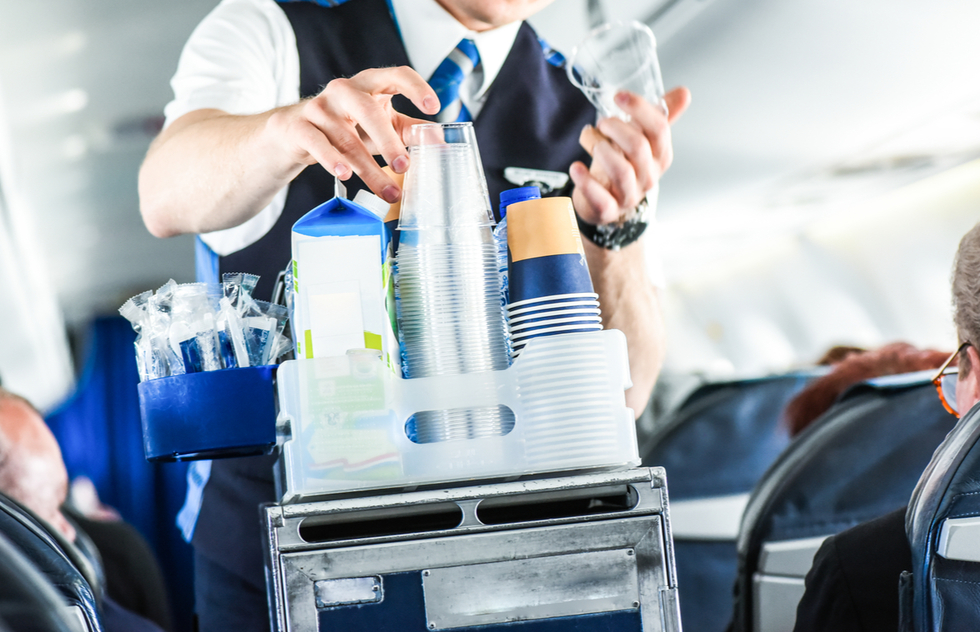It should come as no surprise that the healthiest thing to drink on a plane is water, which also happens to be the healthiest thing to drink on land.
Inside an airplane cabin, the air is extremely dry, putting you at heightened risk of dehydration. That can lead to nausea, headaches, and other unpleasant outcomes. Medical pros recommend drinking about a cup of water each hour you’re on the plane.
What Not to Drink
We’re not talking about cups of tap water, however. Though U.S. federal law supposedly requires airlines to provide safe drinking water, a 2019 scientific study concluded that passengers should avoid drinking tap water on planes due to the frequency with which airline water is found to contain harmful bacteria and the infrequency with which aircraft water tanks are cleaned (blech).
Because most flight crews brew onboard coffee and tea using the tap water, the study’s authors advise against sipping those beverages as well.
As a mild diuretic, caffeine can contribute to dehydration. But that’s not why you should avoid sweetened carbonated drinks. The high altitude makes fizzy sodas foam up and take forever to pour, slowing in-flight beverage service to a crawl (flight attendants have particular disdain for Diet Coke). Besides, the combo of dry air and low cabin pressure dulls your tongue’s sensitivity to sweetness, so the soda isn’t going to taste right anyway.
What to Drink Instead
Scientists and safety experts would have you stick to room-temperature bottled water—not from that open pitcher on the beverage cart and not with ice (which may contain harmful bacteria).
Sounds like a real treat, doesn’t it?
For something a little more exciting, a good bet is either one of two soft drinks that seem to be more popular in the skies than on terra firma, and for good reason.
The first is ginger ale, which really does taste better on planes—it’s not your imagination. The same dry air and low cabin pressure that muffle your taste buds’ sweetness sensors—making Diet Coke taste like sticky muck—neutralize the oversweetened flavor of ginger ale, resulting in a drier, sharper beverage than on land.
If you’re prone to motion sickness, ginger ale may help settle your stomach, too, though that’s probably from the bubbles and not from any nausea-fighting ginger. Turns out most ginger ale contains very little of its eponymous spice. Come to think of it, there’s no ale in there, either. We’re reminded of what Pee-wee Herman once sang of New York City’s Madison Square Garden: “It isn’t square and it isn’t a garden.”
The other old standby that’s a good choice at 30,000 feet is tomato juice. Purely considering the stuff from a taste perspective, researchers backed by Germany’s Lufthansa airline found that low-pressure environments such as airplane cabins increase the drink’s umami—the rich, savory sensation associated with eating certain meats, cheeses, and mushrooms.
The analysis found that people who don’t even like tomato juice like it a lot better after the air pressure drops.
What About Booze?
The boosted flavor profile of tomato juice on planes points to the Bloody Mary as the ideal in-flight cocktail. But have mercy on your flight attendant and keep it simple: Just ask for vodka and tomato juice. Save the requests for elaborate trimmings for your next brunch outing.
The dry air and pressure changes messing with your sense of taste tend to make sweet, juice-based drinks like vodka-and-cranberry unpleasant. Opt instead for something more bitter and herbaceous like a gin and tonic.
The carbonation in beer causes the same trouble as soda in the skies and you might end up feeling bloated and gassy afterward due to the carbon dioxide bubbles expanding in your digestive tract during flight.
As for wine, it can thin out at high altitudes so go for big, fruit-forward varietals like sauvignon blanc or pinot noir.
It’s a myth that alcohol is more potent at high altitudes, but there are other factors that make drinking in moderation a good idea during your flight.
The main thing to worry about is the risk of dehydration, which alcohol accelerates. So keep chugging on that bottle of water, don’t drink on an empty stomach, and limit your booze intake to a couple drinks.
Never, but never open or consume your own alcohol that you brought on the plane. That’s against FAA regulations and you could get in big trouble if caught.






